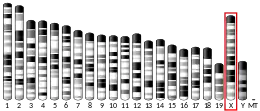| ZMYM3 | |||||||||||||||||||||||||||||||||||||||||||||||||||
|---|---|---|---|---|---|---|---|---|---|---|---|---|---|---|---|---|---|---|---|---|---|---|---|---|---|---|---|---|---|---|---|---|---|---|---|---|---|---|---|---|---|---|---|---|---|---|---|---|---|---|---|
| Identifiers | |||||||||||||||||||||||||||||||||||||||||||||||||||
| Aliases | ZMYM3, DXS6673E, MYM, XFIM, ZNF198L2, ZNF261, zinc finger MYM-type containing 3 | ||||||||||||||||||||||||||||||||||||||||||||||||||
| External IDs | OMIM: 300061 MGI: 1927231 HomoloGene: 3736 GeneCards: ZMYM3 | ||||||||||||||||||||||||||||||||||||||||||||||||||
| |||||||||||||||||||||||||||||||||||||||||||||||||||
| |||||||||||||||||||||||||||||||||||||||||||||||||||
| |||||||||||||||||||||||||||||||||||||||||||||||||||
| |||||||||||||||||||||||||||||||||||||||||||||||||||
| |||||||||||||||||||||||||||||||||||||||||||||||||||
| Wikidata | |||||||||||||||||||||||||||||||||||||||||||||||||||
| |||||||||||||||||||||||||||||||||||||||||||||||||||
Zinc finger MYM-type protein 3 is a protein that in humans is encoded by the ZMYM3 gene.[5][6]
References
- 1 2 3 GRCh38: Ensembl release 89: ENSG00000147130 - Ensembl, May 2017
- 1 2 3 GRCm38: Ensembl release 89: ENSMUSG00000031310 - Ensembl, May 2017
- ↑ "Human PubMed Reference:". National Center for Biotechnology Information, U.S. National Library of Medicine.
- ↑ "Mouse PubMed Reference:". National Center for Biotechnology Information, U.S. National Library of Medicine.
- ↑ Smedley D, Hamoudi R, Lu YJ, Cooper C, Shipley J (Sep 1999). "Cloning and mapping of members of the MYM family". Genomics. 60 (2): 244–7. doi:10.1006/geno.1999.5918. PMID 10486218.
- ↑ "Entrez Gene: ZMYM3 zinc finger, MYM-type 3".
Further reading
- van der Maarel SM, Scholten IH, Huber I, Philippe C, Suijkerbuijk RF, Gilgenkrantz S, Kere J, Cremers FP, Ropers HH (Jul 1996). "Cloning and characterization of DXS6673E, a candidate gene for X-linked mental retardation in Xq13.1". Human Molecular Genetics. 5 (7): 887–97. doi:10.1093/hmg/5.7.887. PMID 8817323.
- Nagase T, Ishikawa K, Nakajima D, Ohira M, Seki N, Miyajima N, Tanaka A, Kotani H, Nomura N, Ohara O (Apr 1997). "Prediction of the coding sequences of unidentified human genes. VII. The complete sequences of 100 new cDNA clones from brain which can code for large proteins in vitro". DNA Research. 4 (2): 141–50. doi:10.1093/dnares/4.2.141. PMID 9205841.
- Scheer MP, van der Maarel S, Kübart S, Schulz A, Wirth J, Schweiger S, Ropers H, Nothwang HG (Jan 2000). "DXS6673E encodes a predominantly nuclear protein, and its mouse ortholog DXHXS6673E is alternatively spliced in a developmental- and tissue-specific manner". Genomics. 63 (1): 123–32. CiteSeerX 10.1.1.322.3999. doi:10.1006/geno.1999.6027. PMID 10662551.
- Hakimi MA, Dong Y, Lane WS, Speicher DW, Shiekhattar R (Feb 2003). "A candidate X-linked mental retardation gene is a component of a new family of histone deacetylase-containing complexes". The Journal of Biological Chemistry. 278 (9): 7234–9. doi:10.1074/jbc.M208992200. PMID 12493763.
- Beever C, Lai BP, Baldry SE, Peñaherrera MS, Jiang R, Robinson WP, Brown CJ (Jul 2003). "Methylation of ZNF261 as an assay for determining X chromosome inactivation patterns". American Journal of Medical Genetics Part A. 120A (3): 439–41. doi:10.1002/ajmg.a.20045. PMID 12838571. S2CID 45505878.
- Beausoleil SA, Jedrychowski M, Schwartz D, Elias JE, Villén J, Li J, Cohn MA, Cantley LC, Gygi SP (Aug 2004). "Large-scale characterization of HeLa cell nuclear phosphoproteins". Proceedings of the National Academy of Sciences of the United States of America. 101 (33): 12130–5. Bibcode:2004PNAS..10112130B. doi:10.1073/pnas.0404720101. PMC 514446. PMID 15302935.
- Cheng J, Kapranov P, Drenkow J, Dike S, Brubaker S, Patel S, Long J, Stern D, Tammana H, Helt G, Sementchenko V, Piccolboni A, Bekiranov S, Bailey DK, Ganesh M, Ghosh S, Bell I, Gerhard DS, Gingeras TR (May 2005). "Transcriptional maps of 10 human chromosomes at 5-nucleotide resolution". Science. 308 (5725): 1149–54. Bibcode:2005Sci...308.1149C. doi:10.1126/science.1108625. PMID 15790807. S2CID 13047538.
- Olsen JV, Blagoev B, Gnad F, Macek B, Kumar C, Mortensen P, Mann M (Nov 2006). "Global, in vivo, and site-specific phosphorylation dynamics in signaling networks". Cell. 127 (3): 635–48. doi:10.1016/j.cell.2006.09.026. PMID 17081983.
This article is issued from Wikipedia. The text is licensed under Creative Commons - Attribution - Sharealike. Additional terms may apply for the media files.




